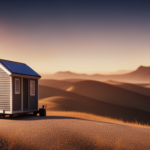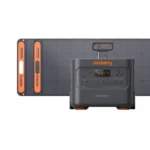Beginners Guides
How Many Batteries For Tiny House
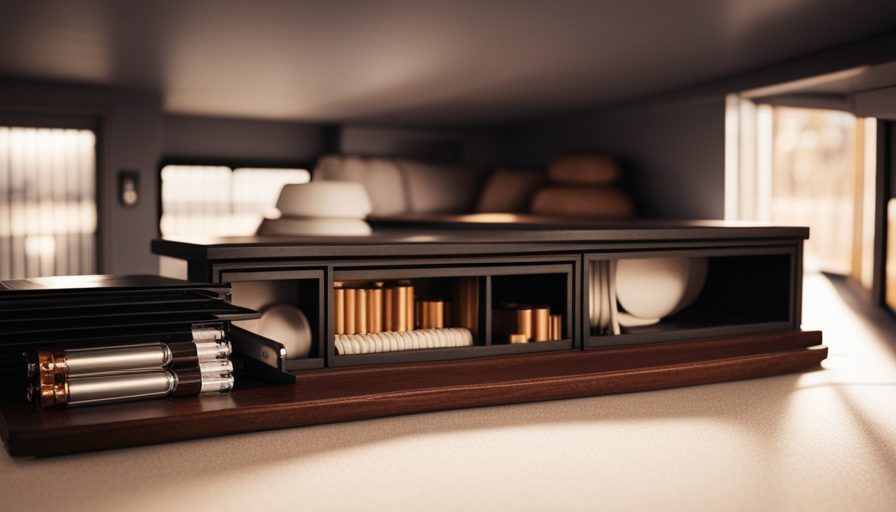
Congratulations on choosing to adopt a minimalist lifestyle and joining the tiny house community! However, before you can fully immerse yourself in the joys of compact living, there’s a crucial question that demands an answer: How many batteries are necessary for your tiny house?
Ah, the irony of it all. In a world where everything seems to be getting bigger and more power-hungry, here we are discussing how to optimize energy consumption in our humble abodes. But fear not, fellow minimalists, for I am here to guide you through this technical and analytical journey.
In this article, we will delve into the nitty-gritty details of:
- Assessing your energy consumption needs
- Choosing the right battery type
- Calculating battery capacity requirements
- Considering alternative power sources
- Understanding charging and discharging rates
- Ensuring proper battery maintenance
- Investing in a battery monitoring system
- Embracing energy efficiency measures
- Seeking professional advice.
So grab your calculators and get ready to embark on an enlightening adventure into the world of batteries for your tiny house!
Key Takeaways
- Assess energy consumption needs and calculate daily energy consumption for a tiny house
- Consider alternative power sources such as solar panels and wind turbines to reduce dependence on traditional battery systems
- Proper battery maintenance is essential for longevity and performance, including regular inspections, maintaining electrolyte levels, and keeping batteries fully charged
- Use shorthand and concise bullet points to streamline the decision-making process and accurately estimate the number of batteries needed for a tiny house.
Assess Your Energy Consumption Needs
You’ll need to assess your energy consumption needs in order to determine how many batteries you’ll require for your tiny house. This step is crucial as it will help you understand the amount of power your appliances and devices consume on a daily basis.
Start by making a list of all the energy-saving appliances you plan to have in your tiny house, such as LED lights, energy-efficient refrigerators, and low-power electronics. These appliances can significantly reduce your overall power consumption.
Next, consider the off-grid power options available for your tiny house. Solar panels are a popular choice among tiny homeowners due to their renewable and sustainable nature. They can provide ample electricity during sunny days while charging the batteries for nighttime use. Wind turbines are another option if you live in an area with consistent wind patterns.
By assessing your energy consumption needs and understanding the off-grid power options available, you can determine how many batteries will be sufficient for your tiny house. This will ensure that you have enough stored energy to power all of your essential appliances and devices throughout the day and night without relying on external sources.
Now let’s move on to choosing the right battery type for optimal performance and longevity.
Choose the Right Battery Type
When choosing the right battery type for my tiny house, I need to compare different battery chemistries and consider factors such as lifespan and maintenance requirements.
It’s important to understand the differences between batteries like lead-acid, lithium-ion, and nickel-cadmium in terms of their energy density, cycle life, and cost.
Additionally, considering factors like how often I’ll be using the batteries and if they’ll need regular maintenance can help me make an informed decision on which battery type is best suited for my energy consumption needs.
Compare different battery chemistries
Lithium-ion batteries, like tiny energetic powerhouses, are a popular choice for small houses due to their high energy density and long lifespan. When comparing different battery chemistries for a tiny house, it’s important to consider factors such as battery cost and environmental impact.
Lithium-ion batteries may have a higher upfront cost compared to other types of batteries, but they make up for it with their superior performance and longevity. They have a longer cycle life and can withstand more charge-discharge cycles without deteriorating significantly. Additionally, lithium-ion batteries are known for their high energy density, meaning they can store more energy in a smaller package. This makes them ideal for small spaces like tiny houses where maximizing space is crucial.
Transitioning into the subsequent section about considering factors such as lifespan and maintenance requirements, it’s essential to evaluate these aspects thoroughly before making a decision on the right battery chemistry for your tiny house project.
Consider factors such as lifespan and maintenance requirements
It’s important to thoroughly evaluate lifespan and maintenance requirements before choosing the right battery chemistry for your compact dwelling. When considering lifespan, it is crucial to assess how long a battery can last before needing replacement. Some chemistries, like lithium-ion, have longer lifespans compared to lead-acid batteries. Additionally, maintenance requirements should be taken into account as they can vary between battery types. Lithium-ion batteries generally require less maintenance compared to lead-acid batteries, which may need regular water refilling and equalization charges. To help visualize the differences in lifespan and maintenance requirements, refer to the table below:
| Battery Chemistry | Lifespan Considerations | Maintenance Requirements |
|---|---|---|
| Lithium-ion | Longer lifespan | Less maintenance |
| Lead-acid | Shorter lifespan | More maintenance |
Considering these factors will ensure that you select a battery chemistry that meets your needs for longevity and ease of upkeep. Transitioning into the subsequent section about calculating the required battery capacity…
Calculate the Battery Capacity Needed
To figure out how many batteries you’ll need for your tiny house, just pretend you’re powering a spaceship and start stockpiling those power cells! Battery capacity estimation is an essential step in designing an off-grid power generation system. It involves calculating the amount of energy your tiny house will consume and determining the battery capacity required to meet that demand.
First, you need to determine your daily energy consumption. This can be done by identifying all the electrical appliances and devices in your tiny house and estimating their power usage. Once you have this information, multiply the total wattage by the number of hours each device will be used to get the daily energy consumption.
Next, consider factors such as weather conditions and seasonal variations in energy requirements. If you live in a location with harsh winters or experience frequent cloudy days, you may need to increase your battery capacity to ensure sufficient backup power during low sunlight periods.
Additionally, think about maintenance requirements when choosing battery technology. Some batteries require regular maintenance like checking water levels or equalizing charges, while others are maintenance-free.
By calculating your battery capacity needs accurately based on these factors, you can ensure a reliable power supply for your tiny house. Now that we have determined the necessary battery capacity, let’s consider alternative power sources for additional flexibility without relying solely on batteries.
Consider Alternative Power Sources
One option you can explore is incorporating solar panels or wind turbines to provide an alternative power source for your off-grid energy needs. These alternative power sources can supplement or even replace the need for batteries in your tiny house. Solar panels harness energy from the sun and convert it into electricity, while wind turbines use the power of the wind to generate electrical energy.
By utilizing these renewable energy sources, you can reduce your dependence on traditional battery systems. When considering alternative power sources, it is important to assess your energy consumption. Evaluate how much electricity you require on a daily basis and determine if solar panels or wind turbines can meet those needs consistently. Keep in mind that these alternative sources are dependent on weather conditions, so it may be necessary to have a backup battery system in place for times when there is limited sunlight or wind.
Understanding charging and discharging rates will be discussed in the subsequent section about ‘understand charging and discharging rates.’ This knowledge is crucial for optimizing battery performance and ensuring efficient utilization of alternative power sources.
Understand Charging and Discharging Rates
Understanding the charging and discharging rates is crucial for optimizing battery performance and ensuring efficient utilization of alternative power sources. Here are four key factors to consider when evaluating charging efficiency and battery lifespan:
-
Charging Rate: The speed at which a battery can be charged affects its overall efficiency. Rapid charging may result in higher energy losses due to heat dissipation, reducing the charging efficiency over time.
-
Discharging Rate: Similarly, the rate at which a battery is discharged impacts its performance. High discharge rates can lead to voltage drops and decreased capacity, affecting both the functionality and lifespan of the battery.
-
Depth of Discharge: It is essential to understand how deeply a battery can be discharged before recharging it. Excessive depth of discharge can accelerate wear and tear on batteries, ultimately shortening their lifespan.
-
Temperature Effects: Extreme temperatures impact battery performance significantly. High temperatures increase self-discharge rates, while low temperatures reduce overall capacity.
By considering these factors, you can plan for an optimal battery bank sizing that meets your tiny house’s energy requirements without compromising longevity or efficiency.
Transitioning into the subsequent section about planning for battery bank sizing, it is important to assess these aspects carefully to ensure a reliable power supply for your tiny home needs.
Plan for Battery Bank Sizing
Consider how you can efficiently size your battery bank to meet the power needs of your compact living space while maximizing longevity and performance. Calculating the appropriate battery bank size is crucial for ensuring a reliable and sustainable power supply in your tiny house.
To determine the battery capacity needed, you must first estimate your daily energy consumption. This involves assessing the power requirements of all your appliances, lighting, and other electrical devices, as well as accounting for any planned expansions or future additions.
Once you have an idea of your daily energy consumption, you can move on to calculating the battery capacity required. The formula for this calculation is relatively simple: divide your estimated daily energy consumption by the depth of discharge (DOD) percentage and multiply it by the number of days’ worth of backup power desired. The DOD represents the amount of usable energy that can be extracted from a fully charged battery before recharging becomes necessary.
After determining the required battery capacity, you need to consider other factors such as efficiency losses due to temperature fluctuations and system inefficiencies when choosing specific batteries for your bank. Additionally, it’s essential to ensure proper battery maintenance to prolong their lifespan and maintain their performance.
By accurately sizing your battery bank based on careful calculations and estimations, you can provide sufficient power while optimizing longevity and performance in your tiny house setup. Properly maintaining these batteries will further enhance their reliability and durability in meeting your power needs without compromising efficiency or functionality.
Ensure Proper Battery Maintenance
To ensure your battery bank remains efficient and reliable over time, it’s crucial that you diligently maintain them, treating them like the lifeblood of your power supply. Battery maintenance is essential for maximizing their lifespan and preventing common issues that can arise.
Here are some battery maintenance tips to keep in mind:
-
Regularly check the electrolyte levels: Monitoring the electrolyte levels in your batteries is important because low levels can lead to decreased performance. Add distilled water if necessary.
-
Clean the terminals: Dirty terminals can hinder proper charging and discharging of batteries. Use a wire brush to remove any corrosion or buildup on the terminals.
-
Keep batteries fully charged: Avoid deep discharges by regularly recharging your batteries to their full capacity. This helps prevent sulfation, which can decrease battery efficiency.
-
Store batteries properly: If you’re not using your tiny house for an extended period, make sure to disconnect and store the batteries in a cool and dry place.
-
Perform regular inspections: Check for any signs of damage or leaks in your battery bank. Addressing these issues promptly can prevent further damage.
By following these battery maintenance tips, you can troubleshoot common battery issues and ensure optimal performance for years to come. Investing in a battery monitoring system will provide additional insights into their health and assist with proactive management.
Invest in a Battery Monitoring System
Investing in a battery monitoring system will enhance your ability to effectively manage and maintain the performance of your power supply over time. Battery capacity optimization is crucial for maximizing the efficiency and lifespan of your batteries, especially in a tiny house where space is limited.
With a battery monitoring system, you can closely track the state of charge, discharge rates, and overall health of your batteries. This technology provides real-time data that allows you to identify any potential issues or abnormalities early on.
A battery monitoring system also ensures that you’re getting the most out of your batteries by optimizing their capacity. By closely monitoring their performance, you can adjust charging and discharging patterns to avoid excessive strain on the batteries and prevent premature degradation. This will ultimately extend their lifespan and save you money in replacement costs.
Furthermore, a battery monitoring system provides valuable insights into energy usage patterns within your tiny house. By analyzing this data, you can identify areas where energy efficiency measures can be implemented to reduce overall power consumption. Transitioning into the subsequent section about ‘consider energy efficiency measures,’ it’s important to take advantage of this information to further optimize your power supply and minimize waste.
Consider Energy Efficiency Measures
Are there ways to make your energy consumption more efficient in order to maximize the lifespan of your power supply? Absolutely! By incorporating energy efficiency measures into your tiny house, you can reduce the amount of electricity you require and ultimately extend the life of your batteries. One effective way to achieve this is by investing in energy-saving appliances. These appliances are specifically designed to use less power without compromising on performance, making them ideal for off-grid living. Additionally, implementing insulation techniques such as using double-glazed windows, insulating walls and floors, and sealing any air leaks can greatly reduce heat loss or gain, resulting in lower energy demands.
To further emphasize the significance of energy efficiency measures, let’s take a look at this emotion-evoking table:
| Energy Efficiency Measure | Benefits |
|---|---|
| Energy-saving appliances | Lower electricity bills |
| Insulation techniques | Enhanced comfort levels |
| Reduced environmental impact | Decreased carbon footprint |
By embracing these measures, not only will you save money on electricity bills but also enjoy improved living conditions while minimizing your ecological footprint.
Considering these energy-saving strategies is essential when planning for a tiny house battery setup. Seeking professional advice will help you optimize your approach and ensure that you create an efficient and sustainable power system for your tiny home.
Seek Professional Advice
Now that we’ve explored various energy efficiency measures for a tiny house, it’s crucial to seek professional advice before making any decisions regarding the number of batteries required. Seeking professional guidance ensures that you make informed choices and optimize the battery installation process.
When it comes to determining how many batteries your tiny house needs, consulting with an expert in the field is highly recommended. They possess the knowledge and experience to assess your specific energy requirements and provide accurate recommendations tailored to your unique situation.
Here are four reasons why seeking professional advice is essential:
-
Expertise: Professionals have a deep understanding of battery systems and can guide you towards the most suitable options for your tiny house.
-
Optimal Performance: With their expertise, professionals can help you choose batteries that’ll maximize energy storage and usage efficiency.
-
Cost-Effectiveness: By seeking professional advice, you can avoid overspending on unnecessary batteries or undersizing your system, saving both money and resources.
-
Safety: Proper installation of batteries is crucial for safety reasons, and professionals can ensure that all electrical connections are made correctly.
By engaging with professionals who specialize in battery installations for tiny houses, you can make well-informed decisions about the number of batteries needed while ensuring a smooth installation process.
Frequently Asked Questions
Can I use the same type of batteries for all my energy needs in a tiny house?
Yes, it’s possible to use the same type of batteries for all energy needs in a tiny house. However, using different types of batteries for different energy needs can be more efficient and cost-effective.
By matching specific battery types to each energy requirement, such as deep-cycle batteries for long-term storage and lithium-ion batteries for high-power applications, you can optimize performance and extend battery life.
Using a single type of battery may lead to potential risks like limited capacity or inadequate power supply for certain devices or appliances.
What are some alternative power sources that can be used in conjunction with batteries for a tiny house?
What alternative power sources can be used with batteries in a tiny house?
Are solar panels and wind turbines viable options?
Solar panels harness the energy of the sun and convert it into electricity, which can then be stored in batteries for later use.
Wind turbines, on the other hand, generate electricity by converting the kinetic energy of the wind into electrical energy.
Both these sources can supplement battery power and provide sustainable energy for a tiny house.
How often do I need to replace the batteries in my tiny house?
Batteries in a tiny house typically last around 4-8 years, depending on usage and maintenance. To extend their lifespan, proper care is crucial. Regularly check battery levels and ensure they’re not overcharged or discharged deeply. Using a Battery Management System can help optimize performance.
Signs indicating the need for replacement include reduced capacity, frequent low voltage warnings, longer charging times, and increased self-discharge rates. It’s important to monitor these factors to maintain an efficient power system.
What are some energy efficiency measures that can be implemented to reduce battery usage in a tiny house?
To reduce battery usage in a tiny house, implementing energy efficiency measures is crucial. One effective way is to invest in energy-efficient appliances that consume less power.
Additionally, installing solar panels can greatly decrease the reliance on batteries by generating renewable electricity.
By optimizing appliance usage and harnessing solar energy, the need for frequent battery replacements can be minimized, resulting in long-term cost savings and environmental benefits.
How do I properly dispose of old or damaged batteries from my tiny house?
To properly dispose of old or damaged batteries from my tiny house, I should consider battery recycling. It’s essential to handle these batteries with care due to their potential environmental impact. Battery recycling centers are equipped to safely collect and process various types of batteries, ensuring that harmful substances are disposed of correctly.
By utilizing battery recycling services, I can contribute to reducing pollution and protecting the environment from the negative effects of improper battery disposal.
Conclusion
In conclusion, when it comes to determining how many batteries are needed for a tiny house, it’s crucial to assess your energy consumption needs and choose the right battery type. By calculating the battery capacity required and considering alternative power sources, you can ensure uninterrupted power supply.
Understanding charging and discharging rates, as well as proper battery maintenance, is essential for maximizing battery lifespan. Investing in a battery monitoring system and implementing energy efficiency measures will further optimize energy usage.
Seeking professional advice can provide valuable insights tailored to your specific requirements. Remember, every watt counts!
Hi, I’m Emma. I’m the Editor in Chief of Tiny House 43, a blog all about tiny houses. While tree houses are often associated with childhood, they can be the perfect adult retreat. They offer a cozy space to relax and unwind, surrounded by nature. And since they’re typically built on stilts or raised platforms, they offer stunning views that traditional homes simply can’t match. If you’re looking for a unique and romantic getaway, a tree house tiny house might just be the perfect option.
Beginners Guides
How Cheap Can a Tiny House Shellon Wheels Cost
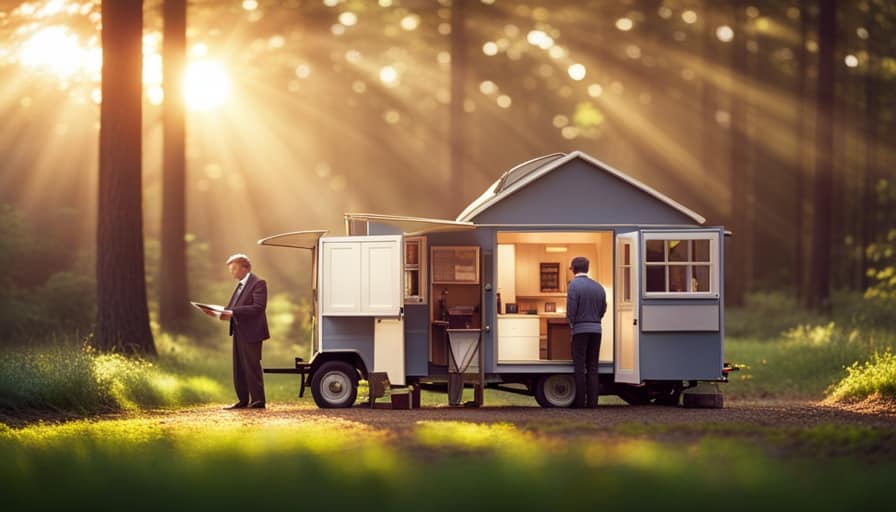
I have exciting news for all the budget-friendly tiny house fans out there! Brace yourself, as we are about to explore the realm of extremely affordable tiny house shells on wheels.
You won’t believe how cheap these gems can be. I’ve done my research, and I’m here to spill all the details on finding the best bargains, DIY methods, and cost-saving tips for customizing your dream home.
So, buckle up and prepare to embark on a journey towards affordable tiny house living!
Key Takeaways
- Affordable options for tiny house shells include using budget-friendly materials like reclaimed wood, recycled metal, and alternative building materials.
- DIY methods for building a budget-friendly tiny house shell include using reclaimed or salvaged materials, incorporating creative space-saving solutions, and repurposing items for storage.
- Bargains for cheap tiny house shells on wheels can be found by searching online marketplaces, attending local auctions, researching and comparing prices, and negotiating the price.
- Cost-saving tips for customizing a tiny house shell include utilizing multipurpose furniture, taking on DIY projects, maximizing storage with shelves and hooks, and looking for cost-saving hacks like repurposed furniture and DIY decor.
Researching Affordable Tiny House Shell Options
I’ll start by exploring different manufacturers that offer affordable tiny house shell options. When it comes to constructing a tiny house shell on a budget, it’s essential to consider using budget-friendly materials. Many manufacturers understand the need for cost-effective solutions and offer options that cater to this market. These include using materials like reclaimed wood, recycled metal, and alternative building materials. By using these budget-friendly materials, you can significantly reduce the overall cost of your tiny house shell build.

In addition to using budget-friendly materials, there are creative ways to save money on a tiny house shell build. One option is to purchase a pre-built tiny house shell from a manufacturer. This allows you to take advantage of their bulk purchasing power and expertise to get a high-quality shell at a lower cost. Another option is to explore DIY kits that come with pre-cut materials and instructions, allowing you to save money by doing the construction yourself.
Transitioning into the next section, let’s now explore DIY methods for building a budget-friendly tiny house shell.
Exploring DIY Methods for Building a Budget-Friendly Tiny House Shell
Let’s delve into various DIY techniques to construct a budget-friendly tiny house shell.
When it comes to building a tiny house on a budget, exploring alternative materials is key. Instead of traditional lumber, consider using reclaimed or salvaged materials to save money and reduce waste.

Additionally, creative space-saving solutions can make a big difference in maximizing the functionality of your tiny house. Utilize multifunctional furniture, like a sofa that converts into a bed or a foldable dining table.
Think outside the box and repurpose items for storage, such as using old suitcases as shelves or installing hooks on walls for hanging pots and pans.
Finding Bargains: Where to Look for Cheap Tiny House Shells on Wheels
Scouring online marketplaces and attending local auctions can be effective strategies for finding cheap tiny house shells on wheels. When searching for affordable options, it’s important to know where to look and how to negotiate the price. Here are some tips to help you in your search:
- Best websites for finding affordable tiny house shells on wheels:
| Website | Description |
|---|---|
| Tiny House Listings | A popular online marketplace for tiny houses |
| Craigslist | Local classifieds often have listings for shells |
| eBay | Auction-style platform with various options |
- Tips for negotiating the price of a cheap tiny house shell on wheels:
- Do your research and compare prices to know the market value.
- Be prepared to negotiate and offer a lower price.
- Highlight any repairs or modifications needed as leverage for a lower price.
- Consider purchasing in the off-season when prices might be lower.
Cost-Saving Tips for Customizing Your Tiny House Shell
When customizing my tiny house shell, I often look for cost-saving tips to stay within my budget. Here are some customization ideas and space-saving solutions that can help you save money while still creating a functional and beautiful tiny home:
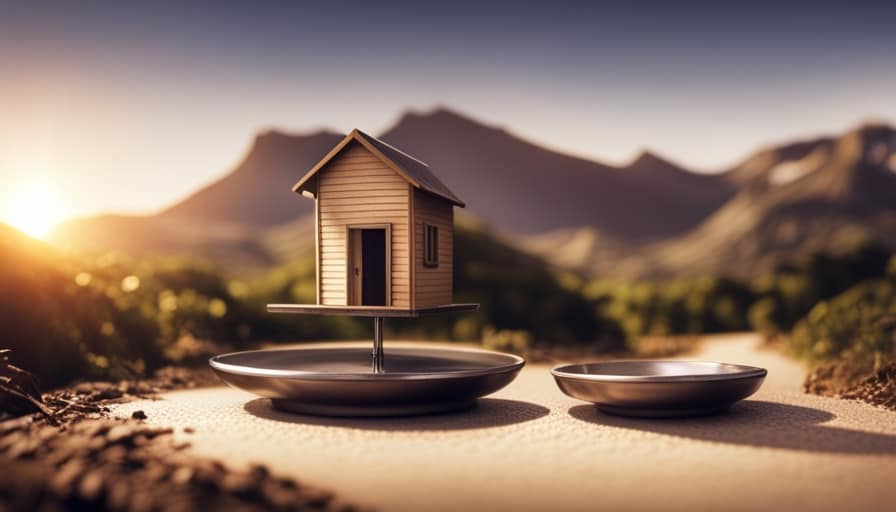
-
Utilize multipurpose furniture: Look for furniture pieces that can serve multiple functions, such as a sofa that can be transformed into a bed or a table with built-in storage.
-
DIY projects: Instead of buying expensive custom-built furniture or storage solutions, consider taking on some do-it-yourself projects. You can repurpose old materials or find affordable options at thrift stores or online marketplaces.
-
Optimize vertical space: Maximize storage by utilizing vertical space. Install shelves, hooks, and hanging organizers to make the most of every inch. You can also consider using wall-mounted folding tables or Murphy beds to save space.
Comparing Prices: How Much Can You Save With a Tiny House Shell on Wheels?
I saved a significant amount of money by comparing prices and opting for a tiny house shell on wheels rather than a traditional home. When I started exploring financing options for my tiny house, I was amazed at how much more affordable it was compared to a conventional house. Not only did I save on the initial cost of construction, but I also avoided the expenses associated with buying land and paying property taxes. Additionally, the mobility of a tiny house shell on wheels offers several benefits. I can easily move my home to different locations, allowing me to explore new areas and experience different communities. It also gives me the flexibility to live closer to work or family if needed. Overall, choosing a tiny house shell on wheels has not only saved me money, but it has also provided me with a sense of freedom and adventure.
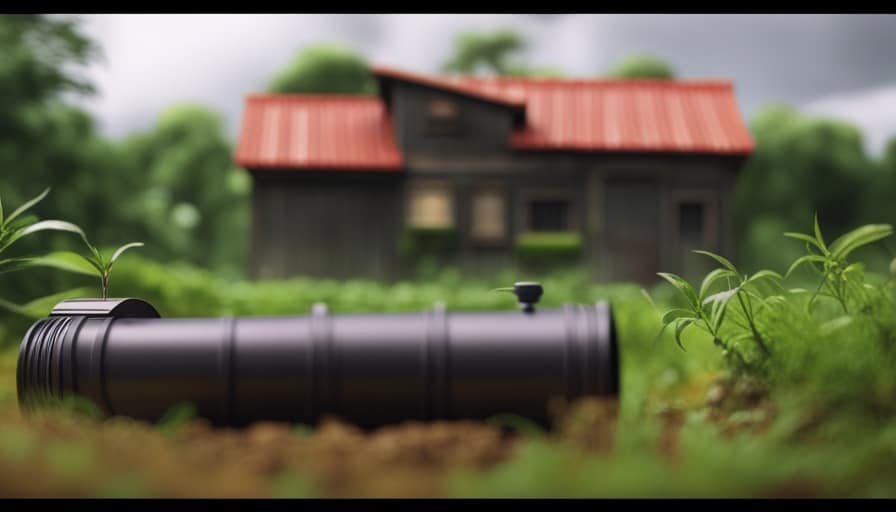
| Benefits of a Mobile Tiny House | Cost Savings |
|---|---|
| Mobility and flexibility | Lower construction cost |
| Opportunity to explore new areas | No property taxes |
| Ability to live closer to work or family | No land purchase expenses |
Frequently Asked Questions
What Are the Common Challenges Faced When Researching Affordable Tiny House Shell Options?
When researching affordable tiny house shell options, one of the common challenges is finding reliable information. It requires thorough research to ensure the options are truly affordable and meet one’s specific needs.
Are There Any Specific Materials or Techniques That Can Help in Building a Budget-Friendly Tiny House Shell?
Budget-friendly materials and construction techniques are essential when building a tiny house shell. By using cost-effective materials and efficient construction methods, it is possible to create a budget-friendly tiny house on wheels.
Where Can I Find Reliable Sources for Cheap Tiny House Shells on Wheels?
Finding affordable tiny house shells on wheels can be a challenge, but with some expert bargain hunting, it is possible to find reliable sources. It’s important to research extensively and compare prices to ensure you get the best deal.
What Are Some Cost-Saving Tips or Hacks for Customizing a Tiny House Shell?
When it comes to customizing a tiny house shell, there are several cost-saving tips and hacks to consider. From using budget-friendly materials to DIY projects, these strategies can help keep your expenses low while still creating a personalized and comfortable space.
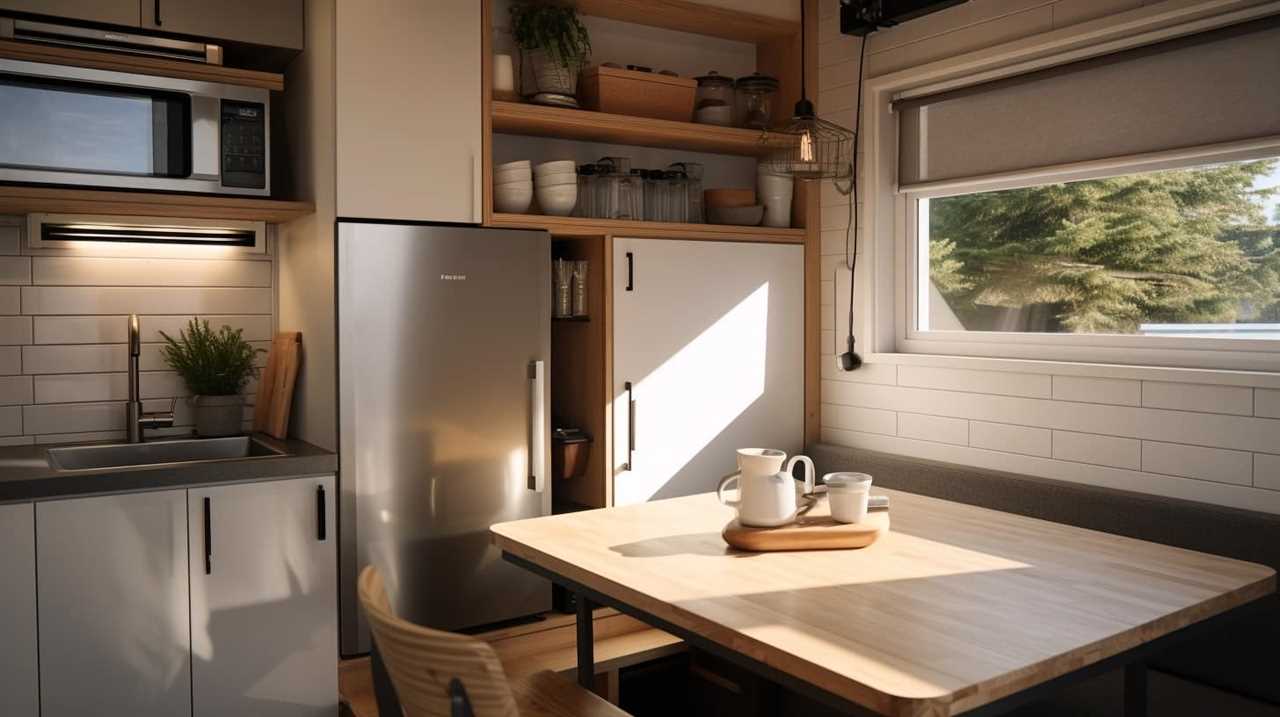
How Does the Price of a Tiny House Shell on Wheels Compare to Other Housing Options in Terms of Long-Term Savings?
In terms of long-term savings, a tiny house shell on wheels can offer significant financial benefits. Compared to other housing options, it allows for lower utility costs and fewer maintenance expenses, making it a cost-effective choice.
Conclusion
After researching affordable options and exploring DIY methods, it’s clear that a tiny house shell on wheels can be an incredibly cost-effective choice.
By finding bargains and utilizing cost-saving tips, individuals can customize their tiny house shell to fit their needs and save even more money.
Comparing prices will reveal just how much can be saved with this practical and budget-friendly housing solution.

So why wait? Take the leap into the world of tiny house living and start saving today.
I’m Theodore, and I love tiny houses. In fact, I’m the author of Tiny House 43, a book about tiny houses that are also tree houses. I think they’re magical places where imaginations can run wild and adventures are just waiting to happen.
While tree houses are often associated with childhood, they can be the perfect adult retreat. They offer a cozy space to relax and unwind, surrounded by nature. And since they’re typically built on stilts or raised platforms, they offer stunning views that traditional homes simply can’t match.
If you’re looking for a unique and romantic getaway, a tree house tiny house might just be the perfect option.
Beginners Guides
How Can You Save Money While Living in a Tiny House on Wheels

As someone who lives in a tiny house on wheels, I’ve discovered that downsizing does not equate to compromising financial stability. On the contrary, it can actually lead to improved financial security!
By embracing a minimalist lifestyle and making smart choices, I’ve discovered countless ways to save money. From efficient energy use to creative storage solutions, this article will show you how to keep more cash in your pocket while enjoying the freedom and simplicity of tiny house living.
Let’s dive in and uncover the secrets to financial freedom on the move!
Key Takeaways
- Incorporate smart home technology to efficiently use energy and reduce utility costs.
- Minimize maintenance costs by regularly inspecting and maintaining all systems and components.
- Utilize creative storage solutions to maximize space and reduce the need for additional storage.
- Grow your own food to save money and enjoy the benefits of fresh, homegrown produce.
Efficient Energy Use
I can save money by using efficient energy in my tiny house on wheels.
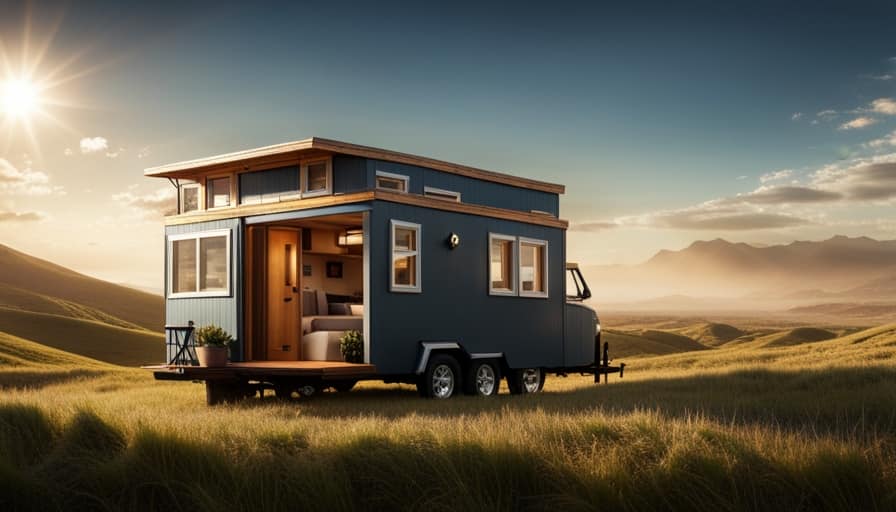
One way to achieve this is by incorporating smart home technology into my energy systems. Smart home technology allows me to monitor and control the energy consumption of my appliances and devices remotely. By using smart plugs, smart thermostats, and smart lighting systems, I can ensure that energy is only used when needed, reducing wastage and ultimately saving money.
Another way to save money is by utilizing renewable energy sources. Installing solar panels on the roof of my tiny house allows me to harness the power of the sun to generate electricity. Not only is this environmentally friendly, but it also reduces my reliance on the grid and lowers my energy bills. Additionally, using wind turbines or micro-hydro systems can further supplement my energy needs.
Minimizing Maintenance Costs
To minimize maintenance costs while living in a tiny house on wheels, it’s important to regularly inspect and maintain all systems and components. By taking a proactive approach, you can reduce the need for costly repairs and optimize the resources available to you. Here are some practical tips to help you minimize maintenance costs:
| Maintenance Tips | Benefits |
|---|---|
| Regularly check for leaks and water damage | Prevents costly repairs due to water damage |
| Clean and lubricate moving parts | Extends the lifespan of mechanical components |
| Keep the exterior clean and well-maintained | Prevents rust and deterioration |
| Inspect and maintain electrical systems | Reduces the risk of electrical issues and potential hazards |
Creative Storage Solutions
Maximizing storage space is crucial when living in a tiny house on wheels. In order to make the most of the limited space available, it’s important to utilize creative storage solutions.

One way to achieve this is by incorporating hidden compartments into your furniture. For example, you can have a bed with built-in storage underneath or a coffee table that opens up to reveal additional space. This allows you to keep your belongings neatly tucked away, while still having easy access to them.
Another option is to invest in multi-functional furniture. This means choosing pieces that serve more than one purpose. For instance, a sofa that can also be used as a bed or a dining table that can be folded away when not in use.
Growing Your Own Food
One way to save money while living in a tiny house on wheels is by growing your own food and incorporating it into your meals. Vertical gardening and hydroponic systems are excellent options for maximizing space and growing a variety of fruits, vegetables, and herbs.
Vertical gardening involves growing plants vertically, using walls or structures to support them. This allows you to make the most of limited space and grow a larger quantity of produce.
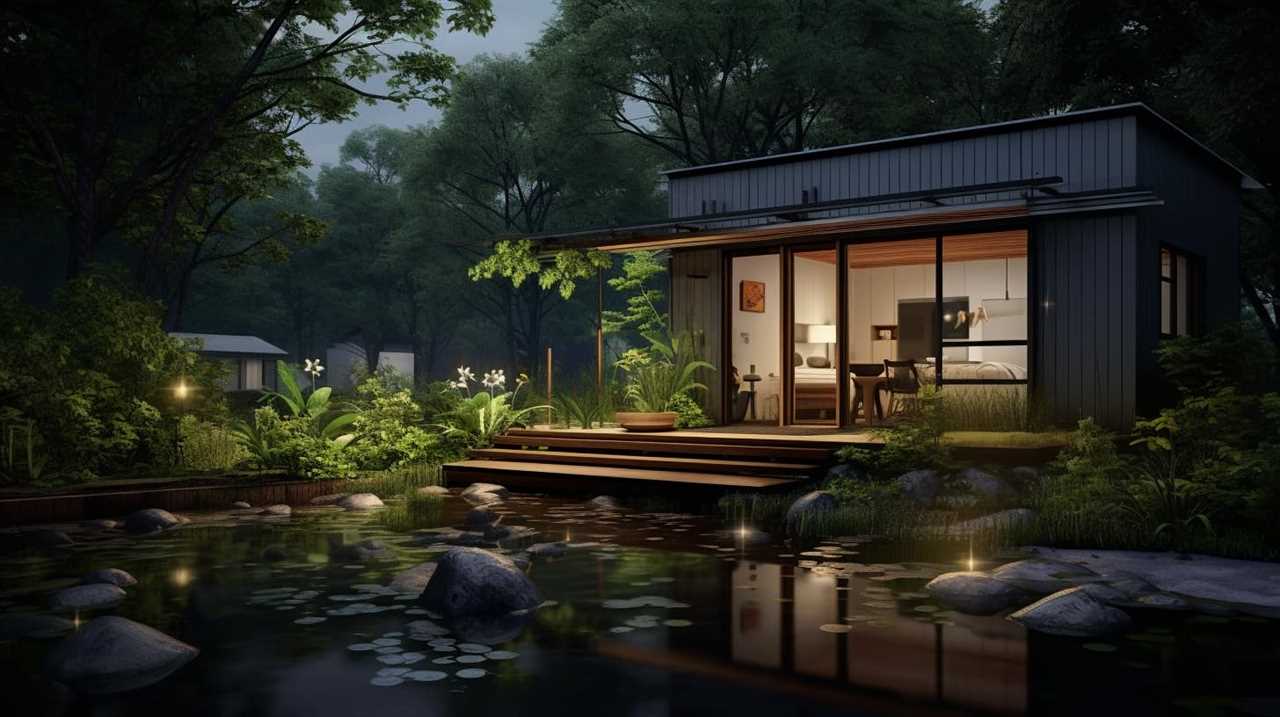
Hydroponic systems, on the other hand, allow you to grow plants without soil, using nutrient-rich water instead. This method is highly efficient and can produce higher yields compared to traditional gardening.
By growing your own food, you not only save money but also have the satisfaction of knowing exactly where your food comes from.
Transitioning into embracing a minimalist lifestyle, let’s explore how to downsize your possessions and simplify your living space.
Embracing a Minimalist Lifestyle
I love the freedom that comes with embracing a minimalist lifestyle in my tiny house on wheels. Living in a small space has forced me to reassess my belongings and prioritize what’s truly important.
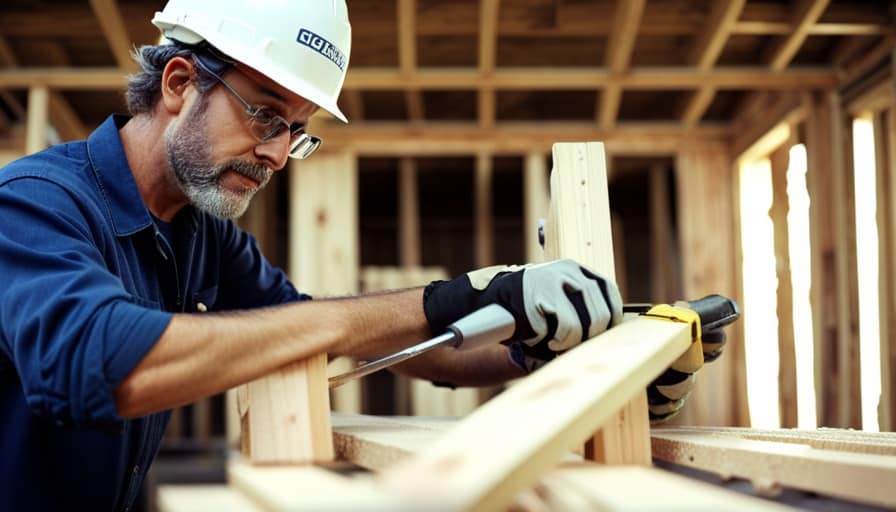
Here are three ways that embracing a minimalist lifestyle in a tiny house on wheels can lead to sustainable living and reduce your environmental impact:
-
Decluttering: By getting rid of excess possessions, you’re reducing waste and promoting a more mindful consumption. This leads to a simpler and more sustainable way of living.
-
Energy Efficiency: With limited space, you become more conscious of your energy consumption. Installing energy-efficient appliances and using natural light can significantly reduce your environmental footprint.
-
Eco-friendly Materials: Choosing sustainable and durable materials for your tiny house, such as reclaimed wood or recycled materials, not only reduces waste but also helps to preserve natural resources.
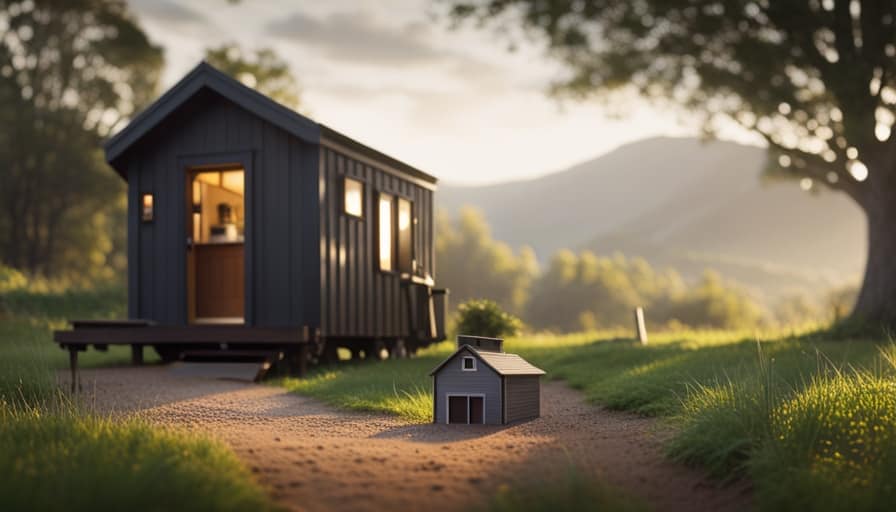
Embracing a minimalist lifestyle in a tiny house on wheels can’t only save you money but also contribute to a more sustainable and environmentally friendly way of living.
Frequently Asked Questions
How Can I Legally Live in a Tiny House on Wheels?
To legally live in a tiny house on wheels, you need to research and comply with local zoning laws and building codes. Ensure your tiny house meets all legal requirements and obtain necessary permits for parking and utilities.
What Are the Potential Challenges of Living in a Tiny House on Wheels?
Living in a tiny house on wheels presents potential challenges, such as limited space and mobility restrictions. However, with some tips and tricks, like minimizing possessions and conserving resources, it is possible to overcome these challenges and live comfortably.
Are There Any Specific Restrictions or Regulations for Parking a Tiny House on Wheels?
Parking restrictions and legal requirements for tiny houses on wheels vary depending on location. It’s important to research local zoning laws, building codes, and permit requirements to ensure compliance and avoid any potential fines or legal issues.
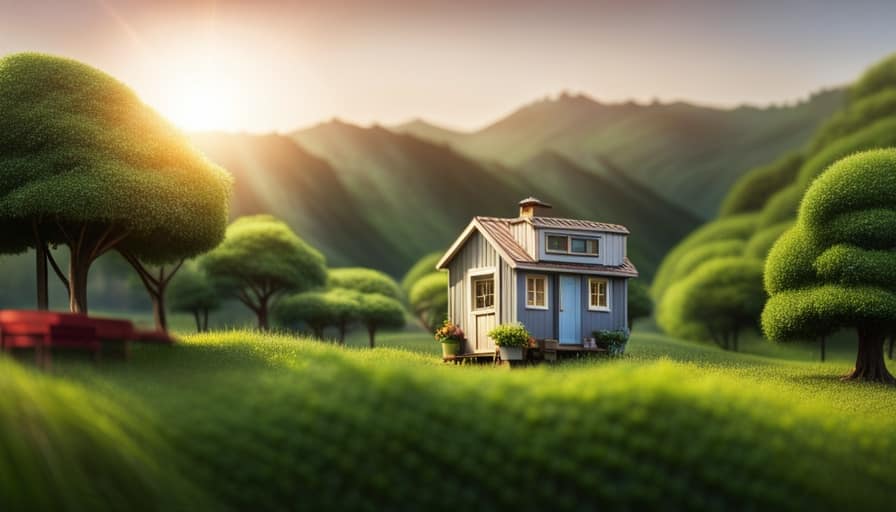
Can I Still Have a Comfortable and Functional Living Space in a Tiny House on Wheels?
Yes, it is possible to have a comfortable and functional living space in a tiny house on wheels. By maximizing storage, utilizing multipurpose furniture, and prioritizing organization, you can create a space that meets your needs.
How Can I Ensure the Safety and Security of My Tiny House on Wheels?
To ensure privacy and prevent theft in my tiny house on wheels, I can implement security measures like installing sturdy locks, using window coverings, and keeping valuable items out of sight.
Conclusion
Living in a tiny house on wheels can be a great way to save money. By focusing on efficient energy use, minimizing maintenance costs, creative storage solutions, and growing your own food, you can significantly reduce your expenses.
Embracing a minimalist lifestyle is also key to saving money in a tiny house. Did you know that the average cost to build a tiny house is only around $23,000, compared to the average cost of a traditional house, which is over $200,000?
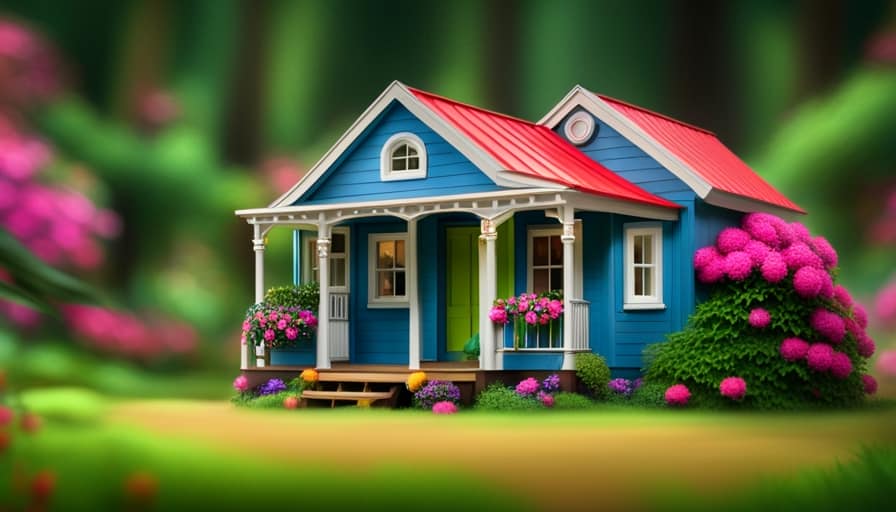
I’m Theodore, and I love tiny houses. In fact, I’m the author of Tiny House 43, a book about tiny houses that are also tree houses. I think they’re magical places where imaginations can run wild and adventures are just waiting to happen.
While tree houses are often associated with childhood, they can be the perfect adult retreat. They offer a cozy space to relax and unwind, surrounded by nature. And since they’re typically built on stilts or raised platforms, they offer stunning views that traditional homes simply can’t match.
If you’re looking for a unique and romantic getaway, a tree house tiny house might just be the perfect option.
Beginners Guides
How Cheap Can I Build a Tiny House Starting Now

- Building codes and safety requirements
- Environmental impact and sustainability measures
I’m here to let you know that constructing a small house doesn’t have to cost a fortune. Visualize a snug area, custom-made to suit your requirements, all within your financial means.
In this article, I’ll share practical tips and strategies for building a cheap tiny house starting right now. From planning your budget to finding affordable materials, I’ll guide you through the process of creating your dream home without breaking the bank.
Let’s get started on this exciting and budget-friendly journey!
Key Takeaways
- Determine available funds and explore different financing options to keep costs low
- Look for affordable building materials at salvage yards, thrift stores, and online marketplaces
- Consider the advantages and disadvantages of DIY versus hiring professionals based on personal preferences and skills
- Incorporate cost-saving design strategies such as using salvaged materials, maximizing space, and incorporating sustainable building methods
Planning Your Budget
I can start planning my budget by figuring out how much money I’ve to work with. It’s crucial to determine the amount of funds available before proceeding with any construction project.
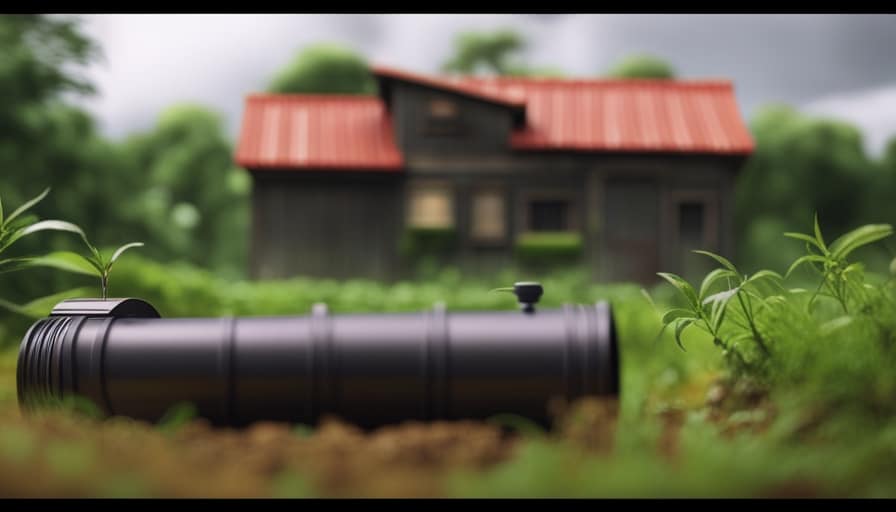
To ensure cost-effective construction methods, it’s essential to explore different financing options. This will help me identify the most suitable approach for my tiny house project. Researching and comparing various financing options, such as personal loans, home equity loans, or even crowdfunding, can provide me with the necessary resources to build my tiny house while keeping costs low.
Additionally, I can consider utilizing cost-effective construction methods, such as using recycled or repurposed materials, which can significantly reduce expenses.
Finding Affordable Materials
How can I find affordable materials for my tiny house project? Here are four ways to save money when it comes to finding materials:
-
Salvaging materials: Look for building materials at salvage yards, thrift stores, or online marketplaces. You can find reclaimed wood, windows, doors, and other items that are in good condition but at a fraction of the cost.
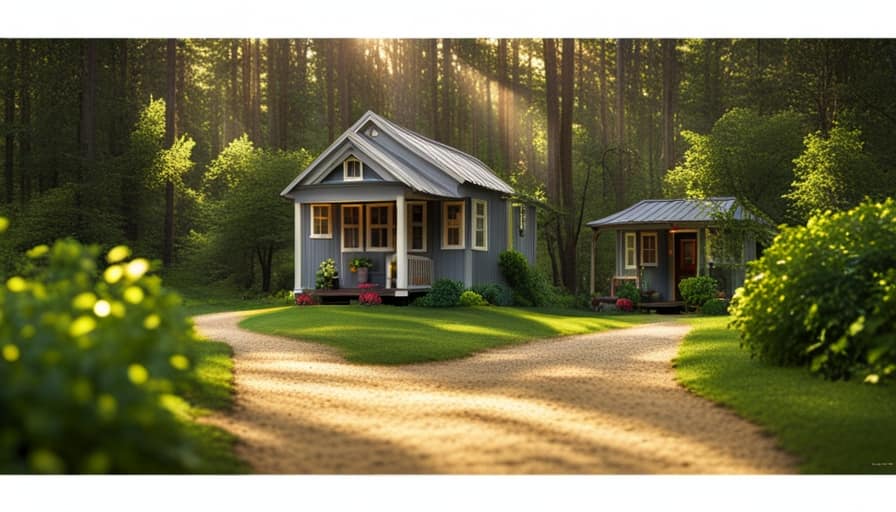
-
Bartering for supplies: Explore the option of bartering with others who may have excess materials or tools. You can trade your skills or services in exchange for the items you need for your tiny house. It’s a win-win situation for both parties involved.
-
Joining community groups: Connect with local community groups or online forums where people share resources and materials for their projects. You can find people who are willing to give away or sell their unused materials at a lower price.
-
Reaching out to local businesses: Contact local construction companies, hardware stores, or home improvement centers and ask if they have any excess or discounted materials. Sometimes, they may have leftover materials from larger projects that they’re willing to sell at a discounted price.
DIY Vs Hiring Professionals
The decision to hire professionals or take the DIY route is an important consideration when building a tiny house. Both options have their pros and cons, and it ultimately depends on your personal preferences and skills. Hiring professionals can ensure that the construction is done efficiently and up to code, but it can also be costly. On the other hand, DIY allows for personal satisfaction and potential cost savings, but it requires more time, effort, and expertise. To help you make an informed decision, here is a table highlighting the advantages and disadvantages of each approach:

| Professionals | DIY | |
|---|---|---|
| Pros | – Expertise | – Personal satisfaction |
| – Efficiency | – Potential cost savings | |
| Cons | – Higher cost | – Time-consuming |
| – Less control | – Requires skills |
Considering the pros and cons of hiring professionals versus taking the DIY route, it’s important to evaluate your own capabilities, budget, and desired level of involvement. Now, let’s explore some cost-saving design strategies for building a cheap but functional tiny house.
Cost-Saving Design Strategies
By employing cost-saving design strategies, I’ve discovered that it’s possible to build a cheap yet functional tiny house. Here are four sustainable building methods and repurposing materials that can help you save money while creating your dream tiny house:
-
Use salvaged materials: Instead of buying new, consider repurposing materials such as reclaimed wood, windows, and doors. You can find these items at salvage yards or online marketplaces, often at a fraction of the cost.
-
Optimize space: Maximize the functionality of your tiny house by designing multi-purpose furniture and storage solutions. Utilize built-in shelving, hidden compartments, and convertible furniture to make the most of every square inch.

-
Energy-efficient design: Incorporate sustainable building methods such as proper insulation, energy-efficient windows, and solar panels. These investments may initially cost more but will save you money in the long run by reducing energy bills.
-
DIY projects: Take on certain tasks yourself, such as painting, flooring, and basic carpentry. By learning new skills and doing the work yourself, you can significantly cut down on labor costs.
Tips for Minimizing Ongoing Expenses
One effective way I’ve found to minimize ongoing expenses is by implementing a monthly budget and tracking my spending. By carefully monitoring my expenses, I’m able to identify areas where I can cut costs and make more sustainable choices.
One important aspect of minimizing ongoing expenses in a tiny house is by investing in energy efficient appliances. These appliances may have a higher upfront cost, but they can significantly reduce energy consumption and save money in the long run.

Additionally, using sustainable building materials can help save on ongoing expenses. Materials such as reclaimed wood or recycled insulation not only reduce environmental impact but also provide cost savings by being more durable and requiring less maintenance.
Frequently Asked Questions
What Are the Necessary Permits and Regulations for Building a Tiny House?
When considering permits and regulations for building a tiny house, it’s important to prioritize adherence to building codes and safety requirements, as well as incorporating environmental impact and sustainability measures into the design and construction process.
How Much Does It Cost to Connect Utilities to a Tiny House?
To connect utilities to a tiny house, the cost will depend on factors like location, distance from existing infrastructure, and type of utilities needed. Off-grid living and alternative energy sources can help reduce the cost of connecting utilities.
Is It Possible to Build a Tiny House Without Any Construction Experience?
Building a tiny house without construction experience is challenging but possible. With tips and tricks for building on a budget and finding affordable materials, anyone can create their dream home.

Are There Any Zoning Restrictions or Limitations on Where I Can Park a Tiny House?
Zoning restrictions and parking limitations vary depending on the location. It’s crucial to research local regulations and consult with the appropriate authorities. Understanding these rules will help ensure a smooth process for parking your tiny house.
How Can I Finance the Construction of a Tiny House?
Financing the construction of a tiny house requires careful planning and budgeting. There are various financing options available, such as personal loans or RV loans. Research different lenders and compare interest rates to find the best deal.
Conclusion
In conclusion, building a cheap tiny house is definitely possible with careful planning and budgeting. By sourcing affordable materials, considering DIY options, and implementing cost-saving design strategies, you can create a functional and cozy living space without breaking the bank.
Remember, every penny saved adds up, so be diligent in finding the best deals and minimizing ongoing expenses. With a bit of creativity and resourcefulness, you can turn your dream of a tiny house into a reality.
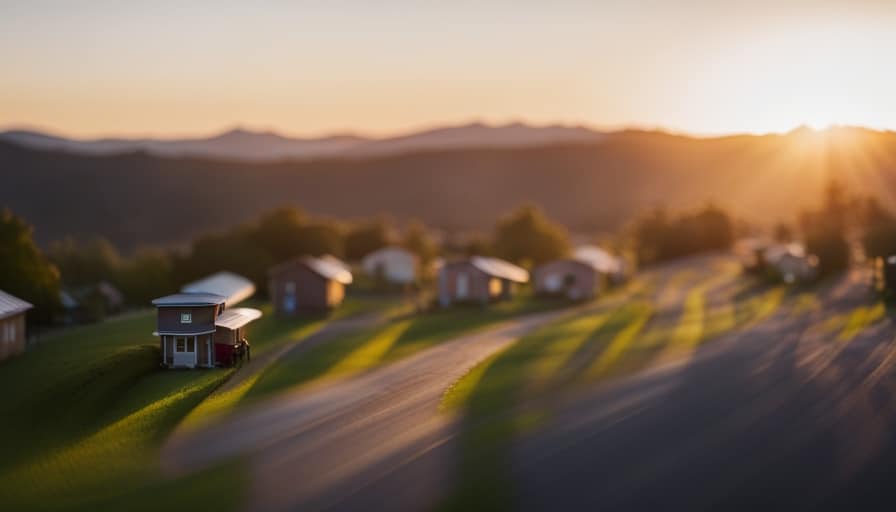
As the saying goes, ‘A penny saved is a penny earned.’
I’m Theodore, and I love tiny houses. In fact, I’m the author of Tiny House 43, a book about tiny houses that are also tree houses. I think they’re magical places where imaginations can run wild and adventures are just waiting to happen.
While tree houses are often associated with childhood, they can be the perfect adult retreat. They offer a cozy space to relax and unwind, surrounded by nature. And since they’re typically built on stilts or raised platforms, they offer stunning views that traditional homes simply can’t match.
If you’re looking for a unique and romantic getaway, a tree house tiny house might just be the perfect option.
-

 Beginners Guides1 week ago
Beginners Guides1 week agoHow To Buy A Tesla Tiny House
-

 Energy Efficiency1 month ago
Energy Efficiency1 month agoBest Tiny Homes For Cold Climates
-

 Beginners Guides6 days ago
Beginners Guides6 days agoTiny House Nation Where Are They Now Stephanie
-

 Tiny House Resources (e.g., legalities, cost, insurance, FAQs)2 months ago
Tiny House Resources (e.g., legalities, cost, insurance, FAQs)2 months agoDo Tiny Homes Need Planning Permission?
-

 Beginners Guides2 weeks ago
Beginners Guides2 weeks agoFrom The Show Tiny House Nation How Many Keep Their Tiny House?
-

 Beginners Guides2 months ago
Beginners Guides2 months agoUsing a Climbing Net For Treehouse Construction
-

 Beginners Guides2 months ago
Beginners Guides2 months agoHow to Build a Treehouse Without Drilling Into the Tree
-

 Beginners Guides3 weeks ago
Beginners Guides3 weeks agoTiny House Nation Who Pays For The Houses






